I tried smoking meat. Here’s how it went.
Congratulations are in order, readers. This week, I celebrated my one year anniversary at Hello Homestead and the Bangor Daily News. It may seem like small potatoes, but it’s a big deal for me — I haven’t lived anywhere for a full year since I graduated college. It’s a satisfying milestone, but also bittersweet. I traveled through most of my early 20s, and sometimes, I miss the adventure. No matter where I am, though, nothing brings me back to the days haggling with hand gestures, living out of a backpack and sleeping under the stars quite like the smell of smoking meat.
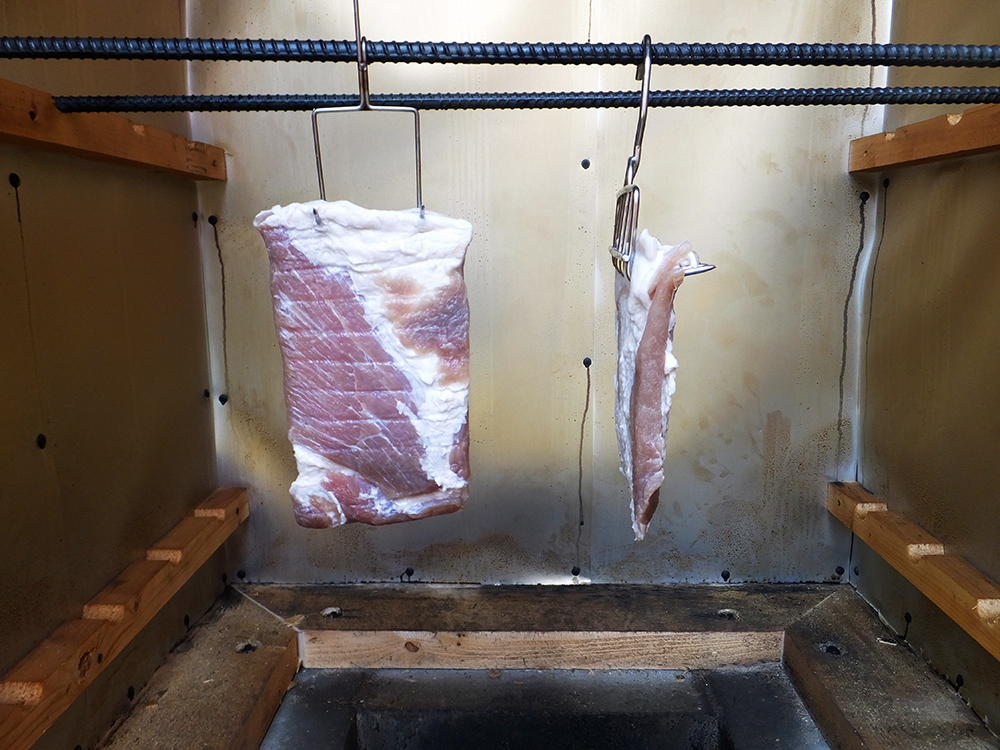
Smoking meat is one of the earliest forms of food preparation and preservation, dating back to the Paleolithic era. Formaldehyde, alcohol and other chemicals in wood smoke act as natural preservatives, kill microbes and slow fat oxidation while drying the meat removes moisture that promotes bacterial growth.
Smoking meat (as opposed to applying direct heat) tenderizes tough cuts and gives meat a unique flavor. When burned, different woods break down into compounds with unique, complex smells and tastes. Smoldering cherrywood, for example, imparts a hint of fruity sweetness, while mesquite smoke leaves a savory, earthy flavor.
Cultures all over the world smoke meat. Everywhere I traveled, someone always seemed to be smoking something, whether it was smoked lamb spit-roasting on the bustling streets of Marrakesh or guinea pig smoking in the volcano-vistaed backyard of a farm in Ecuador.
No matter what is being roasted — or how and where, for that matter — the smokey, meaty scent fills me with adventurous nostalgia. Now that I have settled down in Maine (happily, I might add), learning how to smoke meat for myself seemed like a great way to keep those memories alive.
Learning to try
From the start, I knew exactly who to recruit for my smoking meat: Colt Knight, state livestock specialist and assistant professor at the University of Maine Cooperative Extension. I met Colt while working on the story about a tech-based rural education program he runs using hand-crafted GPS collars for cows.
At the time, he mentioned that he was building a smokehouse in his backyard. Plus, he hosts a number of meat processing and preparation workshops, including an upcoming Barbeque 101 workshop that features — you guessed it — smoking meat.
I called Colt up, and he invited me to his house for a smoking lesson. His smoker was all set up, and he had pork belly prepared for an (ironically, perhaps) all-American smoked classic: bacon.
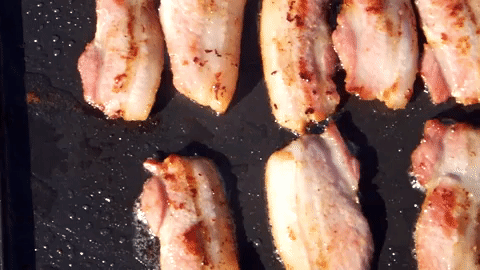
Though you can’t go wrong with smoked Southern barbecue or New York City pastrami, no smoked meat has captured the American cultural consciousness quite like bacon. “Bacon mania” — a phenomenon so pervasive that it has its own thoroughly-cited Wikipedia page — took over the country in the late aughts. For a while, it seemed like bacon was in everything from milkshakes to mints.
This year, though Bacon Nation is sitting on over 40 million pounds of unsold pork belly because producers rushed to meet Chinese pork demand after an outbreak of African swine fever. Though exports may eventually even out the excess, some of that pork belly will find a way into ours (bellies, that is) for now.
There are a few different smoking techniques including low-temperature cold smoking primarily used to preserve meat, high-temperature hot smoking and barbeque smoke-roasting. We would be doing the former, Colt explained. He was already equipped with lump charcoal (never briquettes, he said — some are made with lighter fluid that leave a chemical flavor) and dried hunks of applewood.
Just like in wood-fired stoves, smoking wood is generally seasoned, not green. Also, you should avoid softwoods like pine, cedar and spruce. The porous wood will burn too fast and hot, leaving unpleasant flavors. Besides, the resins in softwoods can release hazardous, potentially-carcinogenic chemicals.
I also asked Colt about some other health concerns, including Listeria bacteria, which can grow in smoked meats when the internal temperature is not properly monitored. In fact, pregnant women are advised not to eat smoked meat at all, lest they pass Listeria-related neonatal infections to their child. I’m not trying to get pregnant, but I still wanted to know the risks.
Colt explained that the curing process — which usually takes about a week, and he would prepare in advance — would help us avoid such nasty bacteria. Curing, essentially soaking the meat in salt, a key step in meat flavoring and preservation. Curing removes moisture and makes meat inhospitable for microbe growth that causes spoilage (and, apparently, Listeria). As a bonus, removing that moisture also makes the meat easier to smoke.
A trying experience
With my food safety fears assuaged, I was finally ready to start makin’ bacon. Even though Colt had cured bacon for our smokehouse experience in advance, he wanted me to experience all the steps of the process, including making the cure and preparing the meat for the curing process.
Colt loaned me a psychedelic apron, and I donned a pair of food-safe gloves. Things were about to get messy.
First Colt pulled a giant, fatty slab of pork belly out of a cooler. Fatty meat retains moisture better in the smoking process — plus, the streaky marbling was perfect for bacon. He used the tip of his knife to point out where the meat was pulled off the ribs.
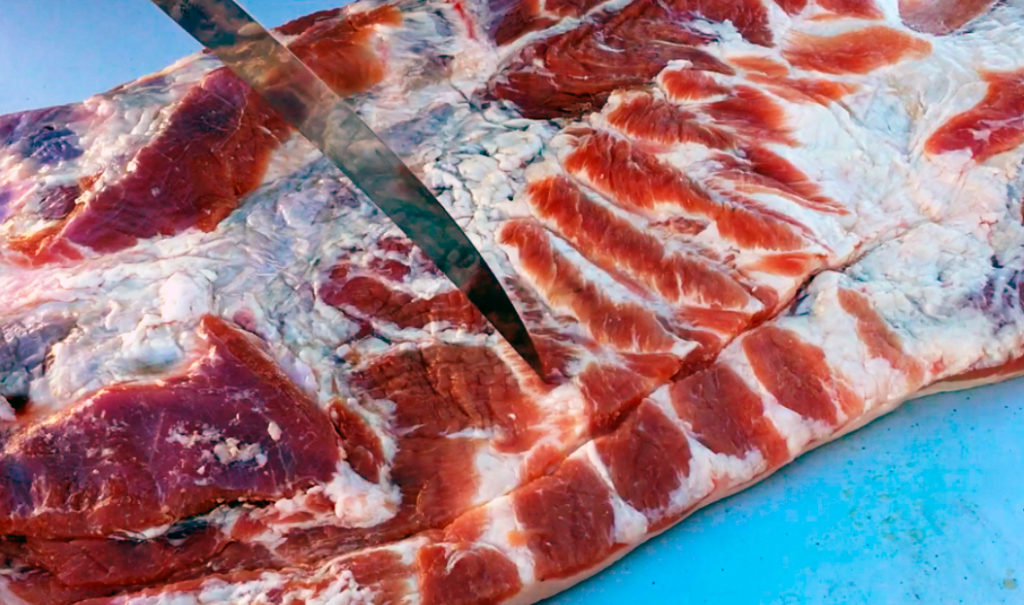
We cut the meat into slabs that would be small enough to put into gallon-sized freezer bags for curing. I was hesitant with the knife at first, but eventually, I let the blade do the work. With the right knife-work, it was like cutting through butter.
Then came curing. Colt used an old Kentucky curing recipe with equal parts kosher salt, maple syrup and brown sugar, plus a touch of pink curing salt. Curing salt, comprised of sodium nitrate and sodium nitrite, is controversial because of its potential carcinogenic effects. Scientists in the United Kingdom even called for banning nitrates in meat for fears of the cancer-causing effects.
While large amounts of nitrates are toxic, Colt explained that they play a key role from a food-safety perspective in curing meat. Moderation is key. We weighed the slabs of meat to figure out how much of the cure — and more importantly, how much curing salt — we were going to use.
I was less shocked by the sprinkle of curing salt than I was by the cups full of kosher salt, sugar and syrup we combined for the cure. It was just a reminder for me: bacon, while delicious — so, so delicious — is by no means a diet food (sorry, keto-maniacs).
We slathered on the cure and rubbed it in. Then, I slid my slabs of meat in a freezer bag. Colt explained that the meat needed to cure in the refrigerators for seven days (one week for every inch of thickness, he explained, and my slabs of pork belly were one inch thick). He recommended flipping the bag every day so the flavors can sneak into every nook and cranny. Over the course of the week, the meat should darken and stiffen.
Luckily, Colt had the pre-cured meat ready my visit. We rinsed the meat to remove some of the excess salt and patted it dry.
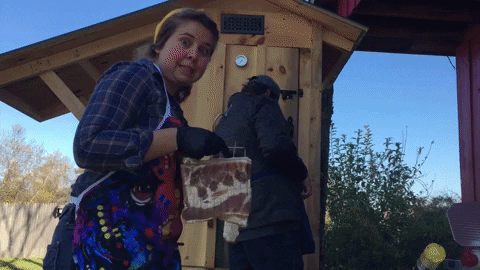
Then, we started the smokehouse. Colt said that he modeled his smokehouse off of an old Appalachian-style smokehouse he remembered from when he was a kid in West Virginia.
We waited for the temperature to reach around 90 degrees so we could begin cold-smoking. Colt realized that maybe we should have started the smokehouse earlier, but we decided to enjoy the beautiful day while we waited. I played with Colt’s extremely well-behaved basset hound, who needed a little bit of attention after we kept her so far from the delicious meats.
Once the smoke was tumbling out of the smokehouse vent, it was time to hang the meat inside. The porky belly looked and smelled beautiful: meaty divas with fog machine entrances.
Once again, though, waiting was the name of the game. Colt explained that the pork belly would have to smoke for four to six hours (sometimes more — he said he takes it out when he likes the color). Some meats even require days to properly smoke.
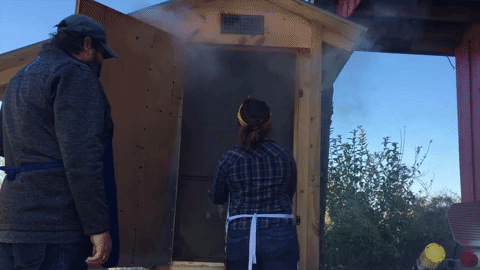
I nearly panicked. I couldn’t play with Colt’s dog for four to six hours; my editor would kill me. Silly me — Colt, of course, was prepared with smoked pork belly that was ready for the next step: slicing. Colt said he even popped the pork belly in the freezer for a little beforehand to make it easier to slice.
Still, I struggled. My knife skills were still lacking, and I sliced the bacon too thick and uneven to properly cook. Colt was patient, but he could tell I was frustrated. He decided to break out the deli slicer. He was a little worried that I might slice my finger off. Little did he know, I was experienced with intimidating spinning blades from my pallet art experience.
Finally, the bacon was ready to cook. Colt hooked up a griddle and added our thick, freshly-smoked slices. (Is there anything as musical as the sound of sizzling bacon? I think not.) Ever the gourmand, Colt also grilled the bread in the extra bacon fat.
The first bite of my bacon sandwich (fully loaded with five slices of bacon, carcinogens be damned) was divine. I may not have been abroad, but that scrumptious sandwich felt like the start of a whole new kind of adventure.
My tried-and-true takeaways
Smoking meat can be capital-intensive and time-consuming, but it is immensely rewarding if you’re looking for flavor. The food safety concerns are legitimate, but easier to navigate through them than it may initially seem (especially if you start with tutelage from an expert like Colt). Certain tools will make the process easier and smoother, and they could be expensive or difficult to DIY (Colt said it only took him a few days and some YouTube videos for him to make his smokehouse, but sans carpentry skills, it would probably take longer).
After a smoking lesson, though, I feel like I could smoke my own meat safety and effectively if I had the proper tools. I wonder if my landlord will let me build a smokehouse in my second-floor city walk-up.
